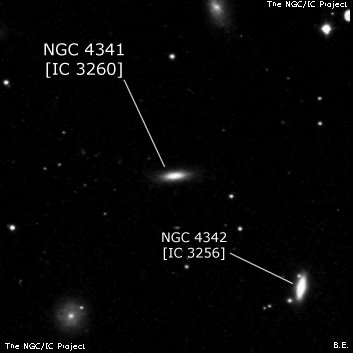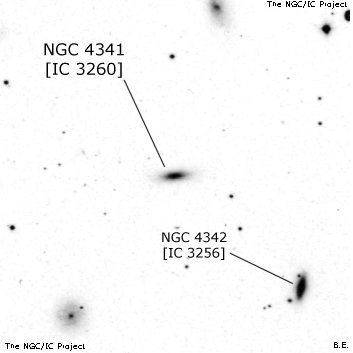NGC/IC Project Restoration Effort
(This is a very very beta version)
NGC4341


Basic Information
Location and Magnitude
Right Ascension: 12:23:53.1
Declination: +7:6:25
Constellation: VIR
Visual Magnitude: 13.2
Historic Information
Discoverer: Herschel W.
Year of discovery: 1784
Discovery aperture: 18.7
Observational
Summary description: eF, vS, R
Sub-type: SB0
Corwin's Notes
=====
NGC 4341 = IC 3260, NGC 4342 = IC 3256, and NGC 4343. There is a group of
five galaxies here to which three NGC numbers and four IC numbers apply.
Needless to say, the identifications are pretty thoroughly scrambled in the
literature. Here is the story:
William Herschel (1786) saw three objects (III. 94-96) here, but gave only one
position for the them. John Herschel included only one of the objects in his
1833 catalogue, calling it "III. 94," the first of the three numbers
assigned by his father. When he prepared the GC, he used his position for
this brightest object, but his father's position for the other two, thus
giving the lowest of WH's numbers to the object with the largest right
ascension. Dreyer used a mean value of JH's position and one from d'Arrest
(1867) for the brightest object, but still had only WH's positions for the
remaining two. Thus, the inverted order of WH's numbers remains in NGC, with
the largest NGC number (4343) receiving the smallest WH number (III. 94).
In sorting out the NGC numbers, I've simply assumed that WH saw the brightest
three galaxies here, and that JH and d'Arrest measured the brightest one of
these. These three galaxies also have the highest surface brightnesses of the
five objects in question, so this is an entirely reasonable assumption to
make (see RC3 for the data). This means, however, that the brightest object,
NGC 4343, has the smallest right ascension on the sky, but the largest RA in
NGC. Also, I've followed RC1 (and most other modern catalogues) by assigning
N4342 to the middle of the three galaxies, and N4341 to the remaining
(following) object, thus retaining the reverse order.
Bigourdan's observations of 1895 and 1907 of all five objects here yielded
four numbers in the second IC. Schwassmann measured four of the five objects
on a Heidelberg plate (the fifth object that he did not measure probably
appears stellar on the plate). Dreyer used these four accurate positions in
IC2; this has led Herzog (1967 and CGCG) to suggest dropping the questionable
NGC numbers altogether, and simply use the unambiguous IC numbers instead.
RC2 and RC3 adopted this solution.
However, this discards two NGC numbers which we can now assign based on modern
photometric data. So, I have adopted the identifications suggested here.
Appendix 6 in RC3 is a table of most known identifications for all five of the
galaxies. The curious are referred to it for cross-references into the modern
literature and catalogues. You should also see NED for the new names added to
these galaxies since 1991.
Steve's Notes
=====
NGC 4341
17.5" (3/28/87): fairly faint, fairly small, elongated ~E-W, even surface brightness. Member of the NGC 4343 group and midway between IC 3259 4.9' NNW and IC 3267 5.0' SSW. NGC identification uncertain and identified as IC 3260 in CGCG and MCG.



